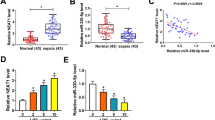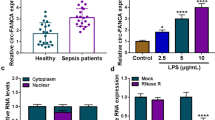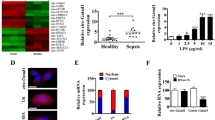Abstract
Background
Long noncoding RNA PVT1 is associated with diverse human diseases, including acute kidney injury (AKI). However, our understandings of PVT1 on septic AKI are limited.
Methods
The septic AKI model was constructed through lipopolysaccharide (LPS) treatment. PVT1 and miR-17-5p levels were measured using qRT-PCR analysis. The concentrations of inflammatory cytokines were determined with ELISA kits. Cell viability and apoptosis were assessed using CCK-8 assay and flow-cytometric analysis, respectively. Protein levels were examined using western blot assay. The targeting association between miR-17-5p and PVT1 was verified by dual-luciferase reporter, RIP and RNA pull-down assays.
Results
PVT1 level was elevated and miR-17-5p level was declined in septic AKI patients’ serum and LPS-stimulated HK-2 cells. Cell viability was suppressed and cell apoptosis and inflammation were promoted after LPS treatment. PVT1 knockdown or miR-17-5p elevation restored LPS-mediated HK-2 cell injury. MiR-17-5p was sponged by PVT1, and its inhibition weakened the impact of PVT1 deficiency on LPS-mediated injury of HK-2 cells. In addition, PVT1 knockdown inactivated NF-κB pathway mediated by LPS treatment, but miR-17-5p inhibition further reversed this effect.
Conclusion
PVT1 knockdown promoted cell viability, suppressed inflammatory response and apoptosis by regulating miR-17-5p expression and NF-κB pathway in LPS-stimulated HK-2 cells.







Similar content being viewed by others
References
Singer M, Deutschman CS, Seymour CW, Shankar-Hari M, Annane D, Bauer M, Bellomo R, Bernard GR, Chiche JD, Coopersmith CM et al (2016) The third international consensus definitions for sepsis and septic shock (Sepsis-3). JAMA 315(8):801–810
Mayr FB, Yende S, Angus DC (2014) Epidemiology of severe sepsis. Virulence 5(1):4–11
Zhi DY, Lin J, Zhuang HZ, Dong L, Ji XJ, Guo DC, Yang XW, Liu S, Yue Z, Yu SJ et al (2019) Acute kidney injury in critically Ill patients with sepsis: clinical characteristics and outcomes. J Invest Surg 32(8):689–696
Singbartl K, Kellum JA (2012) AKI in the ICU: definition, epidemiology, risk stratification, and outcomes. Kidney Int 81(9):819–825
Hotchkiss RS, Swanson PE, Freeman BD, Tinsley KW, Cobb JP, Matuschak GM, Buchman TG, Karl IE (1999) Apoptotic cell death in patients with sepsis, shock, and multiple organ dysfunction. Crit Care Med 27(7):1230–1251
Stoyanoff TR, Todaro JS, Aguirre MV, Zimmermann MC, Brandan NC (2014) Amelioration of lipopolysaccharide-induced acute kidney injury by erythropoietin: involvement of mitochondria-regulated apoptosis. Toxicology 318:13–21
Heo JB, Lee YS, Sung S (2013) Epigenetic regulation by long noncoding RNAs in plants. Chromosome Res 21(6–7):685–693
Wang KC, Chang HY (2011) Molecular mechanisms of long noncoding RNAs. Mol Cell 43(6):904–914
Chen Y, Qiu J, Chen B, Lin Y, Chen Y, Xie G, Qiu J, Tong H, Jiang D (2018) Long non-coding RNA NEAT1 plays an important role in sepsis-induced acute kidney injury by targeting miR-204 and modulating the NF-kappaB pathway. Int Immunopharmacol 59:252–260
Shen J, Zhang J, Jiang X, Wang H, Pan G (2018) LncRNA HOX transcript antisense RNA accelerated kidney injury induced by urine-derived sepsis through the miR-22/high mobility group box 1 pathway. Life Sci 210:185–191
Shen J, Liu L, Zhang F, Gu J, Pan G (2019) LncRNA TapSAKI promotes inflammation injury in HK-2 cells and urine derived sepsis-induced kidney injury. J Pharm Pharmacol 71(5):839–848
Zhao S, Fan NF, Chen XH, Zhuo CH, Xu CW, Lin RB (2019) Long noncoding RNA PVT1-214 enhances gastric cancer progression by upregulating TrkC expression in competitively sponging way. Eur Rev Med Pharmacol Sci 23(10):4173–4184
Ren Y, Huang W, Weng G, Cui P, Liang H, Li Y (2019) LncRNA PVT1 promotes proliferation, invasion and epithelial-mesenchymal transition of renal cell carcinoma cells through downregulation of miR-16-5p. Onco Targets Ther 12:2563–2575
Wang D, Hu Y (2019) Long Non-coding RNA PVT1 Competitively Binds MicroRNA-424-5p to Regulate CARM1 in Radiosensitivity of Non-Small-Cell Lung Cancer. Mol Ther Nucleic Acids 16:130–140
Deng LT, Wang QL, Yu C, Gao M (2021) lncRNA PVT1 modulates NLRP3mediated pyroptosis in septic acute kidney injury by targeting miR20a5p. Mol Med Rep 23(4):1
Huang W, Li X, Wang D, Sun Y, Wang Q, Bu Y, Niu F (2020) Curcumin reduces LPS-induced septic acute kidney injury through suppression of lncRNA PVT1 in mice. Life Sci 254:117340
Georges M, Coppieters W, Charlier C (2007) Polymorphic miRNA-mediated gene regulation: contribution to phenotypic variation and disease. Curr Opin Genet Dev 17(3):166–176
Zhen J, Chen W, Zhao L, Zang X, Liu Y (2019) A negative Smad2/miR-9/ANO1 regulatory loop is responsible for LPS-induced sepsis. Biomed Pharmacother 116:109016
Yao Y, Jia H, Wang G, Ma Y, Sun W, Li P (2019) miR-297 protects human umbilical vein endothelial cells against LPS-induced inflammatory response and apoptosis. Cell Physiol Biochem 52(4):696–707
Cao X, Zhang C, Zhang X, Chen Y, Zhang H (2019) MiR-145 negatively regulates TGFBR2 signaling responsible for sepsis-induced acute lung injury. Biomed Pharmacother 111:852–858
Li J, Lai Y, Ma J, Liu Y, Bi J, Zhang L, Chen L, Yao C, Lv W, Chang G et al (2017) miR-17-5p suppresses cell proliferation and invasion by targeting ETV1 in triple-negative breast cancer. BMC Cancer 17(1):745
Gu J, Wang D, Zhang J, Zhu Y, Li Y, Chen H, Shi M, Wang X, Shen B, Deng X et al (2016) GFRalpha2 prompts cell growth and chemoresistance through down-regulating tumor suppressor gene PTEN via Mir-17-5p in pancreatic cancer. Cancer Lett 380(2):434–441
Wu Q, Luo G, Yang Z, Zhu F, An Y, Shi Y, Fan D (2014) miR-17-5p promotes proliferation by targeting SOCS6 in gastric cancer cells. FEBS Lett 588(12):2055–2062
Ji ZR, Xue WL, Zhang L (2019) Schisandrin B attenuates inflammation in LPS-induced sepsis through miR-17-5p downregulating TLR4. Inflammation 42(2):731–739
Sen R, Ghosal S, Das S, Balti S, Chakrabarti J (2014) Competing endogenous RNA: the key to posttranscriptional regulation. ScientificWorldJournal 2014:896206
Shang AQ, Wang WW, Yang YB, Gu CZ, Ji P, Chen C, Zeng BJ, Wu JL, Lu WY, Sun ZJ et al (2019) Knockdown of long noncoding RNA PVT1 suppresses cell proliferation and invasion of colorectal cancer via upregulation of microRNA-214-3p. Am J Physiol Gastrointest Liver Physiol 317(2):G222–G232
Payen D, Lukaszewicz AC, Legrand M, Gayat E, Faivre V, Megarbane B, Azoulay E, Fieux F, Charron D, Loiseau P et al (2012) A multicentre study of acute kidney injury in severe sepsis and septic shock: association with inflammatory phenotype and HLA genotype. PLoS ONE 7(6):e35838
Liu SF, Malik AB (2006) NF-kappa B activation as a pathological mechanism of septic shock and inflammation. Am J Physiol Lung Cell Mol Physiol 290(4):L622–L645
Tak PP, Firestein GS (2001) NF-kappaB: a key role in inflammatory diseases. J Clin Invest 107(1):7–11
Funding
This work was supported by Jingzhou Science and Technology Bureau Project: Study on the relationship between polymorphism of endotoxin receptor TLR4 gene and susceptibility to sepsis in Jingzhou area (D2018014).
Author information
Authors and Affiliations
Corresponding author
Ethics declarations
Conflict of interest
The authors claim there are no conflicts of interest.
Additional information
Publisher's Note
Springer Nature remains neutral with regard to jurisdictional claims in published maps and institutional affiliations.
Rights and permissions
About this article
Cite this article
Yuan, W., Xiong, X., Du, J. et al. LncRNA PVT1 accelerates LPS-induced septic acute kidney injury through targeting miR-17-5p and regulating NF-κB pathway. Int Urol Nephrol 53, 2409–2419 (2021). https://doi.org/10.1007/s11255-021-02905-8
Received:
Accepted:
Published:
Issue Date:
DOI: https://doi.org/10.1007/s11255-021-02905-8




